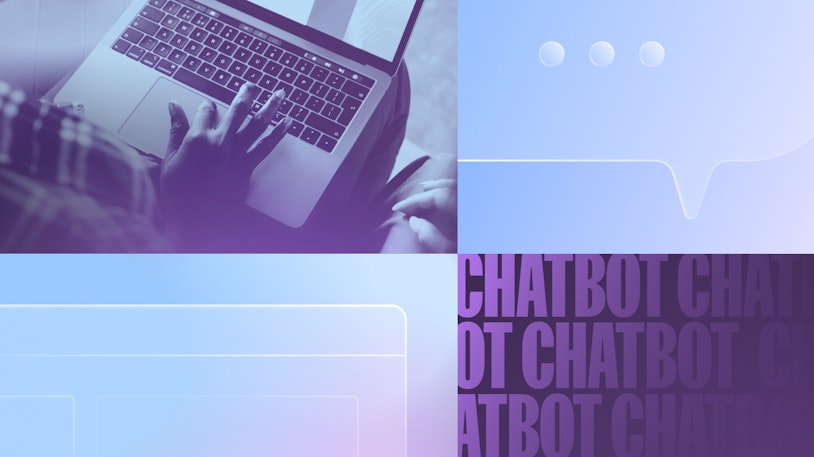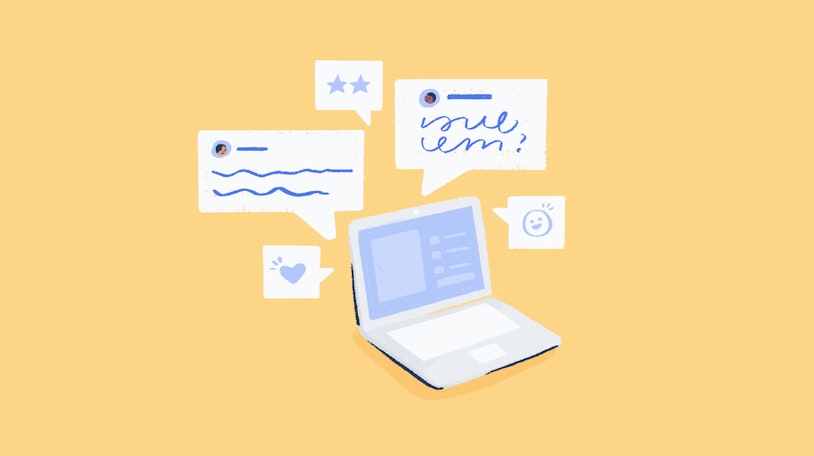Sometimes customers want to talk to a live person. Maybe they’re not finding what they need in your help documentation, or perhaps they want to talk through an issue in real time, and email simply won’t cut it.
Offering live support can really take your customer experience to the next level. Though phone support may be what many think of for live support, there’s another option: live chat. Not only can live chat offer the same immediacy, it’s also less resource-intensive, and it’s the preferred support channel for many.
The 11 best live chat tools for customer support
If you've decided that you need a new tool for offering chat support, get started on your research with our list of the 11 best live chat software of 2024.
Help Scout
Olark
Gladly
Userlike
LiveChat
Chaport
Acquire
Podium
HubSpot
Chatlio
TeamSupport
1. Help Scout
Best live chat tool for complete customer service.
Help Scout offers a great solution for those looking to start using chat. Help Scout's messaging widget, Beacon, lets you provide live chat support, serve customers relevant knowledge base articles, and provide customers with a way to email you when live support isn't available.
When a user fills out the initial chat form, Help Scout’s intelligent routing tool will make sure the query reaches the most qualified chat agent for the topic. When a support agent isn’t available, Beacon lets your customers search your help documentation within the chat widget.
If customers aren't able to find the answers they’re looking for, they can simply send in their request as an email right from the same window, saving a lot of time and hassle.
You can even create automations to automatically trigger a chat box to open when a certain action is taken or certain condition is met, which means you can use Beacon to provide proactive support to customers, too.
Beacon offers three different modes — self service, neutral, and ask first — that let you further curate the chat experience on your page:
In self-service mode, customers see help documentation first, with the option to contact support appearing only after they’ve searched for or viewed an article.
Neutral mode gives customers the ability to choose their own path from the start.
Ask first mode shows contact options first.
From the agent perspective, live chat conversations are managed from within Help Scout's shared inbox, which is packed with features that make chat management easier and more efficient for your team.
Profile information in the conversation sidebar helps you get a complete view of your customer, allowing you to provide contextual support. Saved replies and in-tool access to knowledge base articles let you respond to frequently asked questions more quickly.
AI assist — one of Help Scout's new AI tools — can help you send better responses. AI assist can lengthen or shorten a reply, alter its tone, check for spelling and grammar mistakes, or even translate text into other languages.
Help Scout also offers out-of-the-box reports so you can track performance and understand impact right away. Beacon is included with all Help Scout plans at no additional cost. Finally, Help Scout can integrate with all of your favorite tools, including Shopify and Salesforce, and it's available on desktop, iOS, and Android.
Price: Free trial available. Plans start at $20/user per month.
Learn more about Help Scout:
2. Olark
Best live chat tool for advanced chat needs.
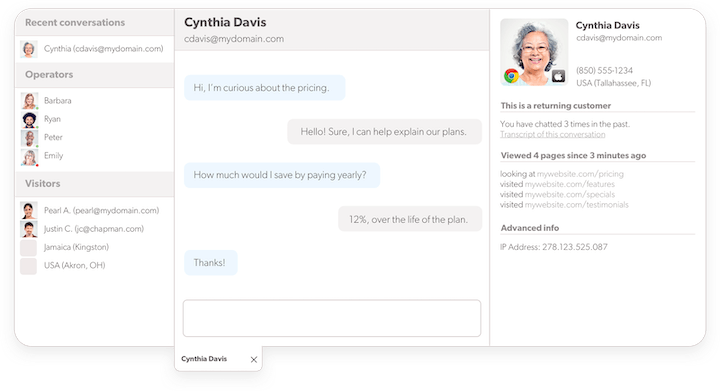
Olark is a dedicated chat tool with lots of advanced features for teams that are planning to use live chat heavily. Along with the standard live chat features, Olark offers automation capabilities and chatbots — artificial intelligence tools used to interact with customers in lieu of a live person — that your team can use for ticket deflection.
Further, you can take advantage of pre-chat surveys to get context and in-depth analytics to better understand where you’re excelling and where you have room to improve. They also offer some very advanced features like live chat translation and co-browsing as optional add-ons.
Price: Free trial available. Plans start at $29/seat per month.
3. Gladly
Best automated chat and ticket resolution.
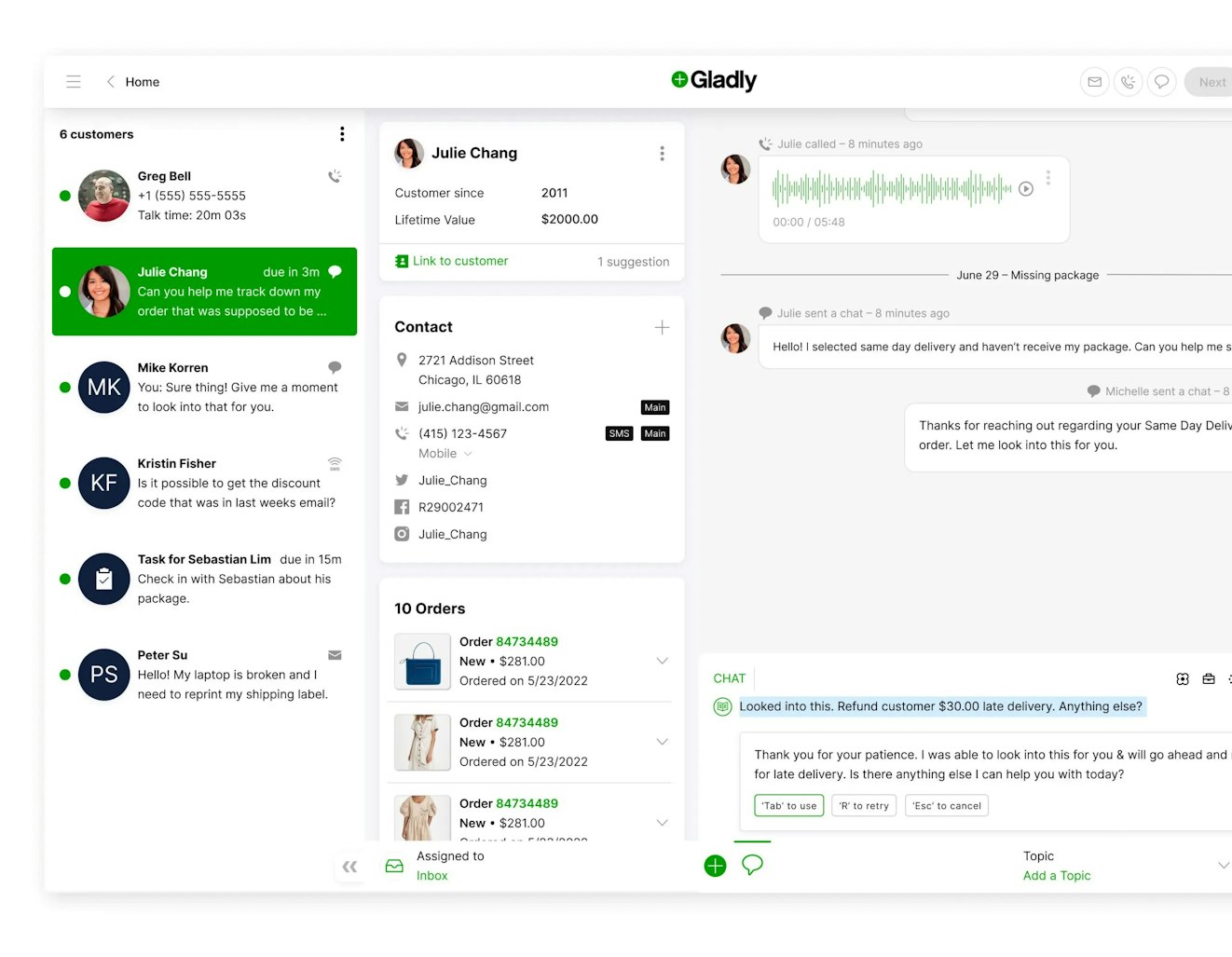
Gladly is a customer service platform that offers live chat as one of its supported channels. Some of their chat experience's main features include proactive messaging, priority routing based on landing page, chat typing indicators, channel-specific reporting, URL tracking, and the ability to accept secure payments via chat.
Gladly also offers some AI options. The authoring feature of its Hero AI tool can help agents alter the length and tone of responses, saving time and improving the quality of responses. Gladly Sidekick and Self-Service Threads can also help you automate the resolution of common customer issues like order tracking, returns, and more.
Price: Paid plans start at $180/hero per month, 10 hero minimum required.
4. Userlike
Best live chat tool for combining personal support and AI service automation.

If you're looking for a professional, all-in-one solution for live chat and customer messaging, then Userlike is the right choice. It’s a unified messaging solution that lets companies receive messages from different channels such as website chat, WhatsApp, Facebook Messenger, Telegram, and more in one central inbox.
It offers a sophisticated website messenger that companies can add to their websites in just a few steps to assist their website visitors along their buyer journeys and nurture long-term customer relationships. Service reps can support customers with powerful service features such as canned messages, file sharing, live translations, voice messages, and video calls that also allow for screen sharing.
To automate their service, companies can benefit from Userlike's AI Automation Hub that lets them create self-learning chatbots, smart FAQ pages, and contact form suggestions, all connected to a central knowledge base that learns over time. Data protection also comes first. That’s why the software is developed and hosted in Germany, making Userlike a GDPR-compliant customer communication solution.
Price: Free trial and plan available. Paid plans start at $90/per month, including four operator seats, four widgets, and two messaging apps.
5. LiveChat
Best live chat tool for targeted messaging.
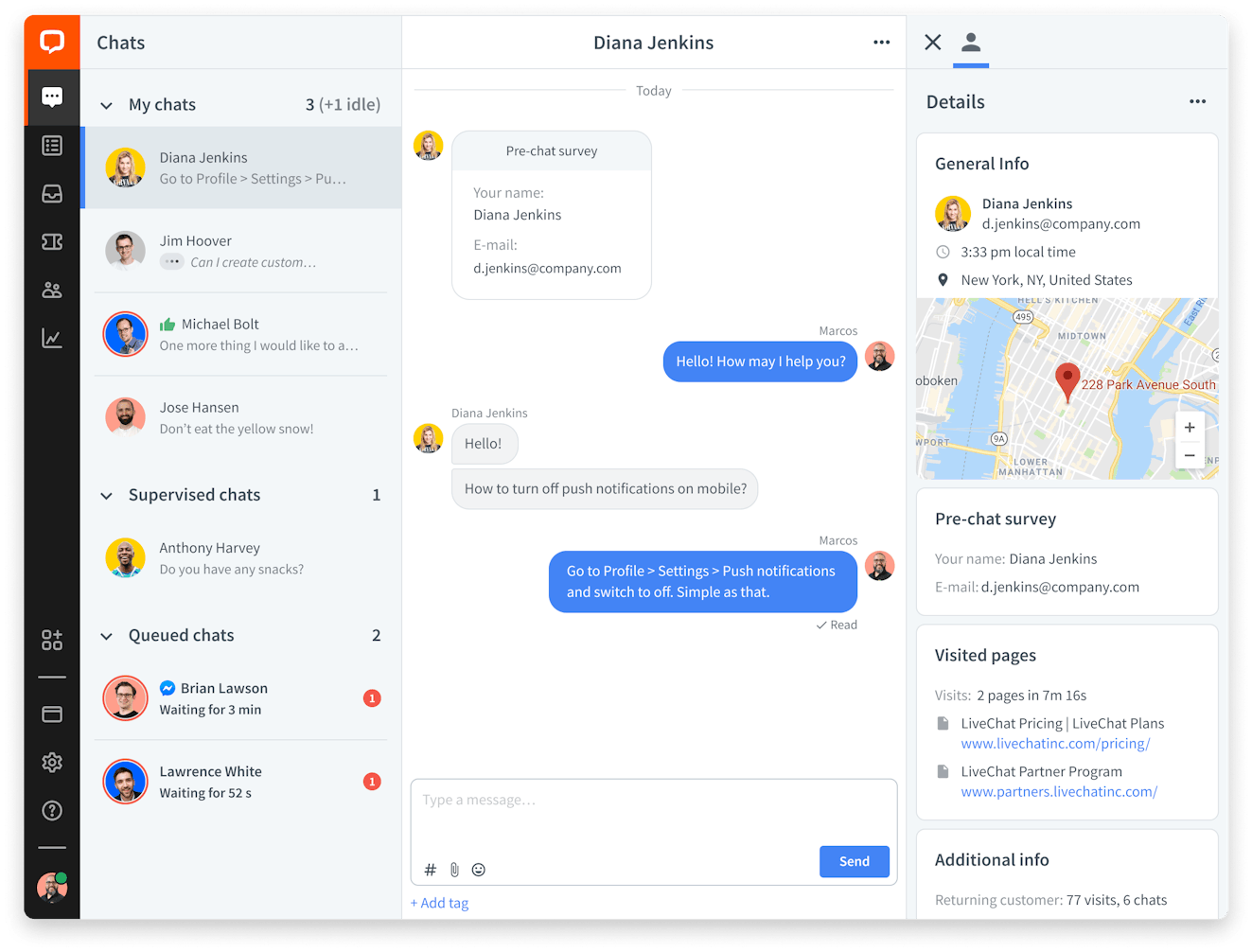
If you’re interested in providing both reactive and proactive support through chat, LiveChat may be a good option for your team. Not only do they offer the ability to chat in real time, they also allow you to automatically send targeted messages to site visitors to proactively engage them.
Coupled with robust reporting, chatbot capabilities, and team management tools, LiveChat is able to handle even the most demanding teams. That said, we should note that the more advanced features and some reporting features are only offered on their higher-cost plans.
Price: Free trial available. Plans start at $20 per month, including one agent.
6. Chaport
Best live chat tool for teams wanting a chatbot.
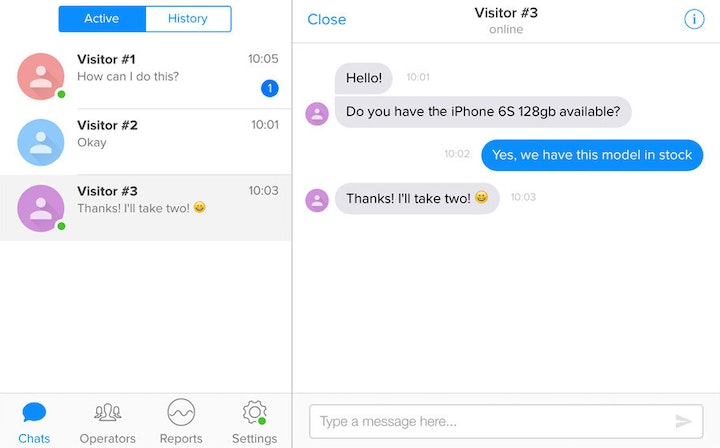
For teams very interested in utilizing chatbots to cut down on initial response times, Chaport is a strong option. You're able to build rule-based chatbot flows and launch them without any coding.
Beyond chatbots, Chaport offers similar features to the chat tools listed above. If you don't need a chatbot, the company also offers a free plan for those who only need very basic chat functionality.
Price: Free plan available. Paid plans start at $29 per month, including four operators. Plans including chatbots start at $99 per month, including unlimited operators.
7. Acquire
Best live chat tool for connecting to messaging accounts.
Acquire is another dedicated support tool. Their offering is very similar to most others on the list, but they do have a key differentiator: They connect with messaging platforms.
For teams that communicate heavily through chat, SMS, and messaging tools like WhatsApp, LINE, Viber, and Telegram, Acquire could be a strong contender. That said, it is a higher-cost tool, which is something to consider.
Price: Free trial available. Plans start at $500 per month plus $25/agent per month.
8. Podium
Best live chat tool for video chat capabilities.
Podium offers a number of different services, including video chat, web chat, and SMS (text) campaigns. Essentially, they’re an entire chat messaging platform.
For teams looking for that expanded functionality, they’re a great option, but they may not make sense for smaller teams or those just starting out with chat.
Price: Plans start at $249 per month, which includes up to three team members.
9. HubSpot Live Chat
Best free live chat software.
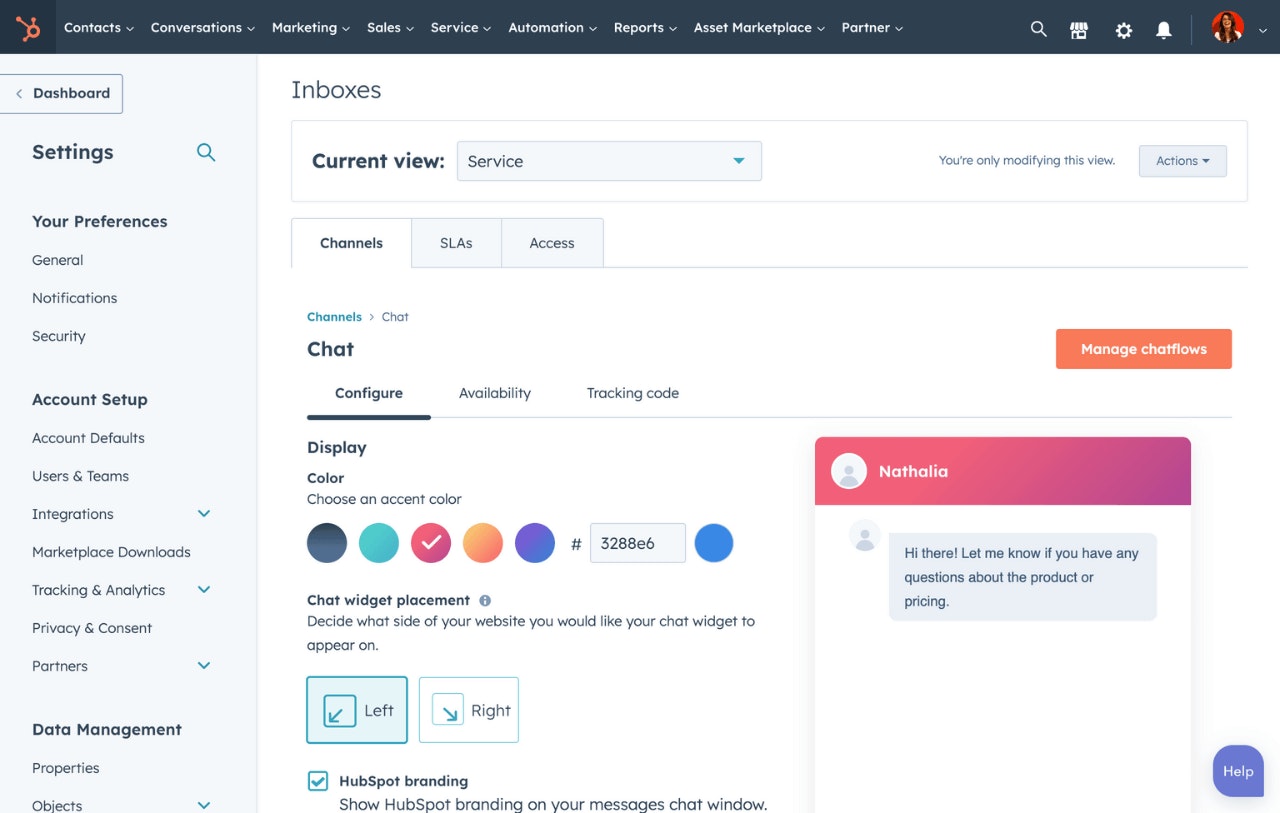
For those wanting to see how chat could work for them but not wanting to invest money upfront, HubSpot Live Chat could be a good option. They offer it as a free service with limited functionality; however, when you’re ready to grow, you can consider signing up for HubSpot’s Service Hub or CRM Suite for additional features.
Price: Free plan available. Paid plans start at $18/month, including two users. Additional users are $9/month each.
10. Chatlio
Best live chat tool for Slack-based communication.
If your team uses Slack, Chatlio could be a great chat option for you. With their app, you’re able to chat with customers directly from Slack. They offer simple setup and some basic customization you can do to make your chat windows on-brand.
There are some plan limits on the lower-priced plans that could be problematic depending on expected volume, but otherwise, it’s a strong contender.
Price: Free trial available. Plans start at $29/month, including two operators.
11. TeamSupport
Best live chat tool for multi-channel chat.
If you need multi-channel chat options or are very interested in chatbot services, TeamSupport could be a strong contender for you. Even on their base plan, they have the ability to chat with people coming in from Facebook Messenger, X (Twitter), SMS, and a few other channels, letting your customers reach out from where they are.
The product has the ability to route chats based on team or product, offers canned responses, and supports proactive messaging to customers while they're on your website. The SneakPeak feature lets you see what a customer is typing before they hit send to give you a head start on troubleshooting, and the platform has analytics to help you keep track of your efforts.
As mentioned above, they also offer a chatbot solution, though it is only available as an optional add-on on their higher-cost plans.
Price: Plans start at $25/agent per month.
How does live chat work?
Live chat support tools generally appear as a pop-up on your website or in your app. When someone opens the chat window, they’re able to type in their message and send it to your support team. The interaction on the customer's end all takes place in the chat window.
The best live chat software will not only let you communicate with your website visitors in real time via a live chat widget, but they will also allow you to schedule messages to trigger when you’re not available or even when a user visits a certain page on your website.
On the agent’s end, the layout is pretty similar to what the customer sees, though there might be information about the customer included in a sidebar.
Some tools may have a slightly different interface, but most function as described above. In fact, some live chat tools will give you a customizable interface that you can show your website visitors, allowing you to upload your brand logo, use your brand colors, and so on.
Generally, an agent sets themselves as “active” to indicate there is a live person ready and responding. In the event that there isn’t a live agent — or someone has been waiting a substantial amount of time for a response — depending on the tool, chats can be converted into email conversations to make sure the message isn’t missed.
The benefits of live chat software
While most support teams start out with email support, there are a lot of good reasons to add live chat to your list of supported channels. Live chat software allows you to:
Increase accessibility to support: Often customers may shy away from seeking support when they perceive the process to be time consuming or incompatible with their schedules. Live chat can be installed on your website or within your app so that customers can seek help quickly and in the moment.
Encourage engagement: Aside from simply giving your customers increased access, many chat support tools also have the ability to proactively launch a chat window during specific moments in the customer journey or when the customer performs a predetermined action. Reaching out and offering a helping hand can help strengthen the customer relationship and increase customer success.
Provide faster support: While email can be a great channel for working through complicated issues, it’s not immediate. Live chat helps you get users the answers they need when they need them.
Increase support coverage: Live chat software makes it easy to provide support even when your agents are offline. Many chat widgets have chatbots or the ability to integrate with a knowledge base, allowing customers to find answers on their own when you’re unavailable.
Improve customer experience: Probably the best reason to consider adding chat to your support lineup is that it's popular. Customers prefer live chat to other channels like email, and customers who interact with companies via chat tend to have a higher rate of customer satisfaction.
These are just a few of the benefits of using live chat software. The specific features and benefits that will be available to you will depend on the type of live chat tool you choose to adopt.
Different types of live chat tools
When thinking about live chat tools, you’re generally choosing between a stand-alone tool and one that’s included as a feature or service of another platform, like a help desk. There are benefits and disadvantages of both.
One of the benefits of a stand-alone tool is that — with its singular focus — it may be able to offer more in-depth analytics specifically about chat. It’s also possible they have other features — like automation or artificial intelligence — that chat tools included as a feature of another service may not have.
The main benefit of using a chat tool that's included in another service is the added utility of the other tools of the platform. Also, depending on the software, there’s the benefit of cost savings over a dedicated chat tool (sometimes chat is an add-on feature with an additional cost).
Overall, an all-in-one support platform may cost a little more per month, but when all parts are considered, they can be a better value.
Features to look for in live chat support software
While the features of a stand-alone tool might look a little different from the features included in a full customer communications platform, there is some functionality that should be present regardless of the option you choose.
Common chat features to look for include:
A customizable chat widget: A chat widget is a small icon on a website or within an app that lets customers initiate a chat with a business. Look for one that can be customized to match your brand’s aesthetics and doesn’t require significant developer involvement to set up.
Messaging channels: Many customers like to initiate real-time conversations with your team through the platforms they already use. Choosing software that can integrate with apps like Facebook Messenger, Instagram, and WhatsApp lets your chat team respond to customer messages from a single platform.
Saved replies: Look for a tool that will let you save templated responses for the questions you get asked the most. This will save time and help standardize the information your team is offering up during a chat session.
Knowledge base integration: An ideal chat platform will have the ability to integrate your knowledge base with the software. This will allow your customers to look up answers on their own via the chat widget and also allow your team to quickly access and share helpful articles with customers during a chat.
Customer management: Having a customer’s profile in the side panel of your team’s dashboard lets them review important data like name, contact details, company, and chat history without leaving the chat. This ensures that your team has all of the data they need to provide helpful, personalized support.
Chat transcripts: It can be helpful for both agents and customers to have access to a chat transcript after the chat has ended. Many software choices will automatically email a chat transcript to your customer immediately following the chat so they can reference it later.
Chatbots: When thoughtfully implemented, rule-based or AI-powered chatbots can help take the stress off of your chat support team. Chatbots can handle some of the easier requests so that customers get quick answers while your team is able to focus their attention on more complicated cases.
Artificial intelligence (AI): AI tools are becoming more and more popular in support settings. While most commonly found in the aforementioned chatbots, AI can also help your agents with drafting responses, researching customer issues, gauging customer sentiment, and performing repetitive tasks.
Integrations: Having software that integrates with the rest of the apps that your team uses can help centralize your support efforts and ensure your team has access to the information they need to be successful.
Reporting: It’s important to be able to measure your efforts, so ensure that the software you choose comes with the ability to report on things like volume, average wait time, and agent performance.
How to choose the right live chat tool for your business
Though there are many things to consider when deciding on a new live chat solution, there are three fundamental questions you should ask:
What’s my need? When deciding on any new tool, it really helps to have a good idea of what you need it for. Perhaps you’re offering tiered support and chat will be part of a higher-tier plan. Maybe you have other customer engagement needs and you want to use it for both support and sales. No matter the case, knowing how you’ll use the tool helps give clarity to what you need from it.
What do I already have? Have you ever gone to the store and picked up some jelly, only to come home and realize there’s a half-full jar sitting in the fridge? To avoid a similar situation, it’s important that you take inventory of the tools you already have access to. For example, if you have help desk software already, it’s possible chat is included in your current platform or offered as an add-on.
What’s my budget? For nearly every team, the cost of a new tool is a big consideration. If you can’t afford something, nothing else about it matters much. However, you do always have to take into consideration the value a product brings as well as the actual cost. A more robust product, though perhaps more expensive, may provide more value and justify the higher price tag.
Learn more about Help Scout:
Finding the right live chat app for your team
Sometimes support needs to happen in real time. For those looking to start offering live support, chat can be a great option. Finding the right solution for your business needs may feel like a tough task, but as long as you’re thoughtful when considering your options, you’ll be on the right path.
If you’re a small (or growing) business looking to provide real-time support for the first time, you’ll benefit from providers that have straightforward pricing and usage limits. Starting at just $20/month, Help Scout is a great option with everything you need to get started with chat support.
Did you know that we also have this guide available in German and French?



